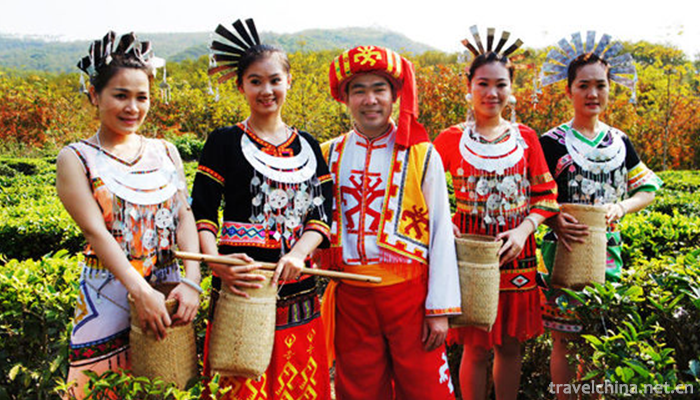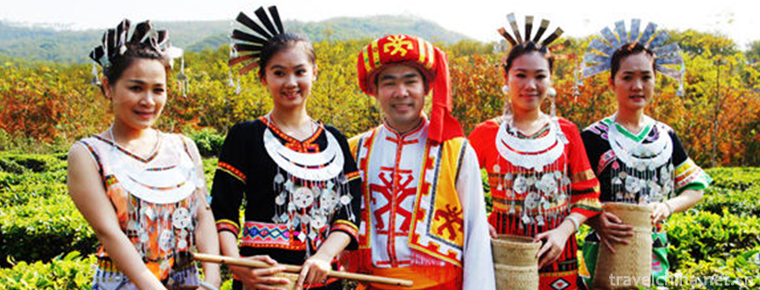Li nationality costumes
Li nationality costumes
Li costumes are mainly made of island cotton, hemp, kapok, bark fiber and silk. In ancient times, some places also used the bark of twig or bloody throat trees as clothing materials. This kind of dress material is made by cutting down the bark from the hill, removing the outer layer of skin residue by beating, leaving the fiber layer, and then soaking and drying with purple cabbage (ash burned from the shell).
Li men usually wear a pair of collarless jacket and trousers, and tie their headscarves to insert pheasant feathers. Women wear black round-collar headdress with many ornaments. The neckline is connected with white and green beads into three sets of edges. The cuffs and hems are decorated with patterns. The front and back are strung with beads in a color pattern. Wear a tight miniskirt underneath. Some wear black and blue flat-collar jackets, white embroidered cuffs, a stripe pattern on the back, a colorful flower dress with folds at the front, silver chains at the head, silver necklaces at the neck, pearl bells at the chest, and silver rings at the hands. The head is tied with a black cloth scarf.
The Li costumes declared by Hainan Jinxiu Zhibei Co., Ltd. on June 14, 2008 were listed in the second batch of national intangible cultural heritage list with the approval of the State Council. (Category: Folklore; Number: _-111)
Historical evolution
Overview
The traditional costumes of Li nationality are brilliant and colorful, and their styles and patterns have local characteristics.
Ancient
Historically, Li women in Hainan Island were skilled in textiles, dyeing and embroidery. They used island cotton, kapok, bark fiber and silk to sew clothes.
Shangshu Yugong records that "island Yihua clothes, pole weaving shellfish" refers to the situation of textiles. The Han Dynasty has "wide distribution", the Tang Dynasty has "Jibeibu", "Panban cloth", "food list" (tablecloth), to the Song Dynasty has "blue and white cloth" and so on. In Book of the Later Han Dynasty, Volume 86, Biographies of Nanman, it is recorded that at the end of Emperor Wu, Sun Xing, a member of the Zhuya Taishou Association, spread his works in a wide range, and was unable to serve, so he attacked the county and killed the fortune.
” In the middle of Tang Dynasty, Li women woven quilts, tablecloths and dish patches with "Jibei" (wild kapok) and were listed as tributes of the court. After the Song Dynasty, the cotton textile skills of the Li nationality became more superb. The women of the Li nationality weaved delicate cotton fabrics such as "Li Jin", "Li Dan", "Li Curtain" and "Li Mantle", which were loved by the people of the Central Plains. There used to be "bark cloth" costumes in Li society. This dress material is made by cutting down the bark of the toon tree or the bloody throat tree on the hill, beating off the outer skin slag, leaving the fiber layer, and then soaking and drying with lime (ash burned from the shell). Li ancestors used this bark fiber to sew clothes, quilts, hats and so on.
Before the founding of the People's Republic of China, most Li costumes were self-spun, self-woven, self-dyed and self-sewn. Their dyes were made of mountain plants, supplemented by mineral dyes. The music history of the Song Dynasty, Taiping Huanyu Ji, Fan Chengda's Guihai Yuheng Zhi, Zhao Rushi's Zhufan Zhi and Zhou Qufei's Lingwai Dai Answer, all have records about the material of Li brocade. For example, "Guihai Yu Heng Zhi" Volume 15: "When the curtain rises in Lidong, Hainan, Li people get Chinese brocade collection, take out color silk, and weave kapok into a single scene with four pieces of kapok." In addition, Volume 6 of Ling Wai Dai Dai Answer reads: "Hainan knitted (Gibeb) is very tasteful! Extremely wide... Between five picks, different lines are shining! ______________ The "Li brocade", "Li dan" and "Li curtain" weaved by the Li people in Hainan are very popular in the Central Plains because of their bright colors, beautiful appearance and applicability.
There are many records about Li costumes in ancient books, such as Han Shu Volume 28 Geographic Records: "In the first year of Emperor Wu Yuanfeng, people slightly thought that Daner and Zhuya prefectures were all clothed, such as single quilt, running through the central government. Shi Gu said,'Write from the beginning to the end'. The women of Li nationality in Mobil dialect have traditional valerian dyeing technology. What Su Shi said in The Story of Junling King's Temple is "weaving flowers" referring to the Li nationality in Mobil dialect. This valerian dyeing method is to tie the pattern on the warp line, then dye, and then weave clothes.
In the course of frequent exchanges with various nationalities on the island, some changes have taken place in the costumes of the Li nationality. The most obvious one is to change the collarless straight jacket and through jacket into digging collar, or to change the straight body, straight seam and straight sleeve to make the waist and cuff seam (fold), or to change the buttonless to decorative button, and later to Pipa button, and finally to change the skirt to biased. The Li people in the Sai dialect, except those in Zuguan and Qunying areas of Lingshui Li Autonomous County, wear flower pots (commonly known as "silk pots"), the rest are embroidered on the skirt tail and waist, and then the jacket is decorated with brightly colored lace. The tube skirts are mostly laced with plaid patterns, and finally only wear blue dresses, black skirts or plain garments without flower patterns.
modern
After the liberation of Hainan in 1950, the costumes of Li nationality changed greatly. According to the social survey data of Li nationality in 1950s, the younger generation in the countryside at that time had generally accepted the Chinese dress, and the older men (over 40 years old) still had their own national coat, but they had changed to wear Chinese trousers or shorts instead of "eaves" (skirts with a piece of cloth hanging from front to back) and "egg wrapping cloth". Women's clothing has been changed from purchased cloth to blouses in terms of material. Dresses are still self-woven. Many people also wear all kinds of shirts and pants they buy. Only middle-aged and old women in remote areas still wear Li costumes. Since the 1980s, few people in Li society have worn ethnic costumes, and young girls in villages are not keen on brocade making ethnic costumes.
Li costumes retain strong national customs and costume characteristics. By 1990, although young men and women of Li nationality had changed into Han clothes in many places, they still wore traditional clothes on marriage, funeral, religious activities and festival days.


-
1.Enshi Grand Canyon
Enshi Grand Canyon is located in Tunpu Township and Banqiao Township, Enshi City, Hubei Province. It is located at the junction of Hunan, Chongqing and Hubei provinces. It is the most beautiful sectio
Time 2018-12-12 -
2.Shangyao National Forest Park
Shangyao National Forest Park, located in the northeast of Huainan City, Anhui Province, has more than 30 hills and mountains with a total area of 10.4 square kilometers and a forest coverage rate
Time 2018-12-19 -
3.Limutai Natural Scenic Area
Limutai Natural Scenic Spot is located at the northernmost end of Tianjin, known as "Tianjin Arctic". In the scenic area, the peak forest and canyon are strong and dangerous
Time 2019-01-29 -
4.Liaoheyuan National Forest Park
Liaoheyuan National Forest Park is located in Dawopu Forest Farm, Pingquan County, Hebei Province. It is named for its birthplace of Liaohe River in China.
Time 2019-01-30 -
5.Zhengzhou Yellow River Scenic Spot
The Yellow River Scenic Spot is located 20 kilometers northwest of Zhengzhou City, capital of Henan Province, on the Bank of the Yellow River. It is situated on Weiyueshan Mountain in the South and Ta
Time 2019-03-18 -
6.Firing Techniques of Chaozhou Coloured Porcelain
In Chaozhou at the end of the Qing Dynasty, new colored pigments were used in the colored porcelain painting. Combining traditional glaze painting art with traditional Chinese painting
Time 2019-04-16 -
7.Heap harmonics
"Heap Harmony" first spread in the Yarlung Zangbo River Basin, the high terrain west of Shigaze to the whole area of Ali circle dance, and later gradually prevailed in Lhasa. It was the firs
Time 2019-04-28 -
8.Foshan Wood Engraving New Year Pictures
Foshan woodcut New Year's picture is a famous folk New Year's picture in South China and a wonderful flower of Lingnan traditional folk culture. It is as famous as the New Year
Time 2019-04-29 -
9.Hu Ji Shu Hui
Hu Jishu Fair is a traditional folk art fair that rose and took root in Huji Town, Huimin County, Shandong Province. Huji is the largest market town in the southeast of Huimin County
Time 2019-05-03 -
10.Huatuo Wuqin Opera
Huatuo Wuqin Opera is a set of guiding techniques compiled by Huatuo, a famous physician in the late Eastern Han Dynasty, according to the principles of traditional Chinese medicine,
Time 2019-05-04 -
11.Fried meat with chili
Stir fried meat with chili is a dish made with chili and streaky pork as the main ingredients and soybeans, garlic seeds, soy sauce, oil salt, monosodium glutamate and ginger as auxiliary ingredients.
Time 2020-03-18 -
12.Yulei mountain
Yulei mountain, according to the original note of "Mian County" in the book of geography of Han Dynasty, "the water of Yulei mountain flows from southeast to Jiangyang and enters into the river." In Shuo Wen, the word "Yu" is written as "the water flows out of Sichuan county, Mian Yu Lei, Shandong Province, and enters the river in the south of Shandong Province
Time 2020-11-08